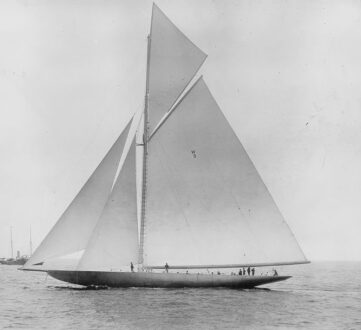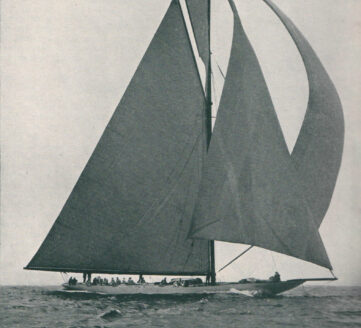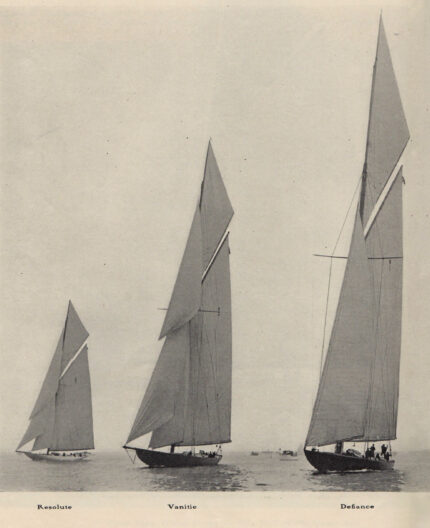Part Three: Captain Nat's Last Campaign (1913 - 1920)
By John Palmieri, Curator Emeritus
The 1920 Cup campaign was unlike any other Capt. Nat had experienced. There was no new boat to design and build; no Herreshoff boats from a previous Cup to refurbish to challenge the new defender. Older brother John Brown Herreshoff (J.B.H.) was gone. Sorely missing was J.B.’s firm hand directing a profitable partnership. Nat was now the president of a stock company, the Herreshoff Manufacturing Co. (HMCo.), accountable to a board of directors. There were few competing projects - never before in a Cup year had the workload been so low. If not for completing the schooner OHONKARA (HMCo. #827) and the new 1919 S Boats in production, the shops would have been empty. Before the year was out the board would decide to indefinitely close the shops, except for small boats and the sail loft. [1]
1915 Preparatory Races
In 1915 Cornelius Vanderbilt chartered VANITIE to race against RESOLUTE (HMCo. #725), adding Butler Duncan (DEFENDER (HMCo. #452) and CONSTITUTION (HMCo. #551) syndicates) to the afterguard and stealing Capt. Christensen from RESOLUTE. Capt. Nat experimented with rigs adding more sail area to increase RESOLUTE’s rating. In the summer’s races VANITIE made some gains, winning four out of sixteen starts.[2] For their part the English considered it extremely unfair of the Americans to race the Cup boats while England was engaged in the “war to end all wars’’.
Negotiating the Challenge 1918 - 1920
Within a month of the Armistice the Royal Ulster Yacht Club (RUYC) challenged for a race in 1919. On Dec. 19, 1918 the NYYC declined, “…with peace not yet concluded, and with a long list of casualties still to be reported, with returning transports bringing home our wounded…it is not appropriate or fitting for us to arrange a …sporting event of such importance as the America’s Cup.” They offered, if challenged to race SHAMROCK IV in 1920 they would defend with one of the boats built in 1914.[3]
On Aug 2, 1919 RUYC proposed conditions for a race to start the next June. NYYC’s Oct. 20th response proposed a July start and to move the race to Newport where the courses, “are free from headlands, with good depth of water and … much less liable to be interfered with by … long tows…It is our experience also that we get better sailing breezes.” They also offered to meet with Marconi rigs (rather than gaff) if the RUYC preferred.[4] NYYC had already made preparations for such a change- three weeks before the offer, Capt. Nat had completed the design of a 166 foot staved hollow wood mast, 20” diameter at the base tapering to 8.5”, for RESOLUTE to carry a “Leg o mutton mainsail”. The design was based upon his recent successful test of such a mast for the NY 50 CAROLINA.[5]
The NYYC complicated the problem for the challenger by insisting upon its right to wait until a week before the first race to name the defender.[6] They were following a two-part strategy; a defender competition between RESOLUTE and VANITIE, and require RESOLUTE to make design changes to increase her rating. The reason, put succinctly by L. Francis Herreshoff, “the press and the general public would be very dissatisfied if she won out with time allowance while coming in last boat-to-boat”.[7]
The RUYC response set the race start at July 15th and declined Newport because New York was the “historic course” and offered “as far as possible” a neutral course.[8]
Preparing for the Races
Work started in November to ready the boats for two months of trials beginning in May. RESOLUTE was fitted out in Bristol, while VANITIE and SHAMROCK IV were worked in City Island.[9]
VANITIE
Alexander Cochran, being in poor health, turned VANITIE over to the NYYC. George Nichols, RESOLUTE’s 1914 navigator and treasurer of the HMCo, was chosen manager and W. Starling Burgess made design improvements- shorter and lighter sail plan, cut down deck edge bulkheads, and more inside ballast. Nichols persuaded Capt. Nat to provide VANITIE a duplicate set of RESOLUTE’s sheet and backstay winches and he ordered from Merriman a full set of RESOLUTE blocks. All the above correcting deficiencies evidenced in the 1914 defender trials.
VANITIE under sail; image courtesy the Library of Congress
RESOLUTE
Capt. Nat increased her rating by adding sail area and replacing the original steel mainmast/telescoping topmast with a light wood staved hollow pole mast. With design work completed he left Bristol on Dec. 18th to winter in Bermuda. While there he sailed in ALERION III, designed and carried on an active correspondence with NYYC’s George Cormack, the RESOLUTE syndicate (C.F. Adams & R.W. Emmons), HMCo General Manager (James G. Swan) and George Nichols.
SHAMROCK IV
Inspected by designer Charles Nicholson, after lying in a South Brooklyn yard since 1914, she was found in good condition except for much work needed to smooth her bottom. This work plus rig changes to reduce rating (reduce the time allowance given the American defender) were accomplished at Jacobs Yard. Meanwhile in England Sir Thomas Lipton had the 23-meter SHAMROCK readied, with design improvements by William Fife, to come over as the trial horse for SHAMROCK IV.
The 1920 Trials
The NYYC Regatta Committee planned to start defender trials on May 21 with five races off New Haven to “get the boats and crews into trim”; then to Newport where starting June 3rd they would race through the month on alternate days under Cup conditions. Meanwhile SHAMROCK IV’s crew was to arrive on May 1st for their two boat trials to begin mid-May off Sandy Hook.[10]
Capt. Nat returned to Bristol in mid-April to oversee RESOLUTE’s final preparations for the trials. Physically, 72-year old Nat was not well; Diary entry “April 27- Have taken cold” and on the evening of April 30, “RESOLUTE moved out of shed. I go to bed in pm with bad cold.” RESOLUTE launched the next day. Nat worked to ready RESOLUTE until May 6th, “Had return of cold and again in bed”. He missed the successful May 9th trial with the new wood mast, and departure for the New Haven races.
RESOLUTE and VANITIE first met on May 22nd and in a heavy squall RESOLUTE’s “mainsheet was slacked out without releasing the topmast & main backstays” causing an uncalculated strain on the new wooden pole which shattered into pieces.[ii] The next day Capt. Nat was up and dressed for the first time in over two weeks and worked for over a month until the problem was fully fixed. In the three days May 24- 26 RESOLUTE was fitted with the original steel mast and a new two foot longer telescoping topmast, but spars and rig modifications to fit the larger sail plan and testing of sails filled the days even after the defender trials resumed on June 3rd.[12] Finally on June 26th RESOLUTE was named as the Cup defender having bested VANITIE eight wins to three. Following her final post-trials overhaul RESOLUTE left for New York and Capt. Nat wrote, “June 30 RESOLUTE left. I go to bed”.
The Cup Races
On July 9th Capt. Nat left Bristol aboard a US Navy destroyer to join RESOLUTE at Bay Ridge where she was drydocked. The days leading up to the July 15th first race were taken up with trying sails, measuring and cleaning the bottom. Nat witnessed most races from the deck of a destroyer, often with the Cup Committee, and between races he was at Sandy Hook aboard the steamer MONTAUK directing fixes and adjustments to RESOLUTE.[13] SHAMROCK IV won the first race in rain and squalls because of poor sail handling aboard RESOLUTE. Eventually RESOLUTE won three races to two in generally light breezes reinforcing the NYYC’s preference to move the Cup to Newport. In the aftermath of the race there was other criticism; the use of time allowance took away from the general interest of spectators; and the vessels were “overrigged and underbuilt except for the lightest weather”.[14]
Nat’s trials with RESOLUTE did not end with the Cup. Upon return to Bristol it took two weeks to haul and move RESOLUTE into the shed. First she was improperly loaded on the railway and slid off; on the second attempt the ways broke down under her weight.[15] Evidence of a less capable work force and neglect of plant maintenance in a declining business environment.
Nathanael Greene Herreshoff and the America’s Cup
When it came to the Cup he was the man for all seasons. Capt. Nat’s run at the Cup had come to an end 28 years after he first designed two Cup boats in 1892 (age 44) for the 1893 Cup. In total he had designed seven boats, five of which had won- his designs held the Cup for an amazing 27 years. It was far from just doing the same thing over and over again, repeating the last success. The competitive scene was constantly changing and through it all he innovated, persevered; and continued to win. Staying one step ahead of his competitors, they always seemed to be designing to beat his last winner.
Consider-
• He won under the Seawanhaka Rule, cyet developed and championed the move to his Universal Rule for a more wholesome yacht and won here to.
• He won with a changing scene of syndicates and captains; first E.D Morgan, C.O Iselin, Charlie Barr and now he had won with the amateur “Corinthians” of 1920.
• He won while taking risks,
o Bronze as a new hull material;
o Introduced aluminum, confident that he could design the details so the dissimilar metals (steel frames; bronze, aluminum and nickel steel plating) would last through at least one season of racing.
o Introduced the longitudinal system of framing offering lower weight, lower construction costs and higher ballast ratios.
o Pushed the Seawanhaka Rule to its extreme- defying critics that he “could not hold it to together”. And when at that peak he led the charge to abandon Seawanhaka for his new Universal Rule.
• He beat the world’s best salesman Sir Thomas Lipton - opposed by Capt. Nat no amount of money could accomplish his dream to “lift the Cup”.
• As the designer and also superintendent of construction he had beat the best England had to offer- Watson, Fife and Nicholson. They the best design talent in England were teamed with the preeminent builders at Denny’s in Dumbarton, a yard of some 4000 employees. Nat and JB did it with a yard of 400.
• He won when he was young and when old, in good health and bad- debilitating rheumatism and weight loss, and through family troubles- loss of his first wife and Cup year fights with JB.
Capt. Nat retired as he had competed – on top, a winner.
John Palmieri
Originally published in the HMM Curator's Log, January, 2016
[1] Board of Directors meeting in Boston Dec. 17, 1920, as recorded in Capt. Nat’s Diary. Access courtesy of Halsey C. Herreshoff.
[2] L. Francis Herreshoff. Captain Nat Herreshoff: The Wizard of Bristol. Sheridan House White Plains NY 1953 Pg. 290.
[3] “No America’s Cup Race This Year”, The Rudder, Vol. XXXV No.1 Jan. 1919. Pg 27.
[4] “America’s Cup Race Conditions”, The Rudder, Vol. XXXVI No.3 Mar. 1920. Pg 33.
[5] “Design for Wood Mast to carry Leg O mutton Mainsail in RESOLUTE (#725)”, NGH Naval Architecture and Engineering Notes Sept. 30, 1919. Access courtesy of Halsey C. Herreshoff.
[6] “America’s Cup Race”, The Rudder, Vol. XXXVI No.3 Mar. 1920. Pg 33
[7] L. Francis Herreshoff. An Introduction to Yachting. Sheridan House, White Plains NY 1963. Pg. 178.
[8] “America’s Cup Race Conditions”, Pg 33.
[9] This section is compiled from the following sources; Capt. Nat’s Diary, LFH. Intro to Yachting, and articles in The Rudder Nov. 1919, and Yachting Jan. 1920
[10] Giles Milby. “News of the Cup Yachts”, Yachting, Vol. XXVII No. 5 May 1920. Pg 203.
[11] LFH, Intro to Yachting. Pg 178-9.
[12] Log of RESOLUTE May 9, 1920 to July 29, 1920. America’s Cup Hall of Fame Archives
[13] Capt. Nat’s Diary
[14] “The Aftermath of the America’s Cup Races”, Yachting, Vol. XXVIII No. 3 1920. Pg 153-156.
[15] Capt. Nat’s Diary July 31, Aug. 2, & Aug. 12, 1920





